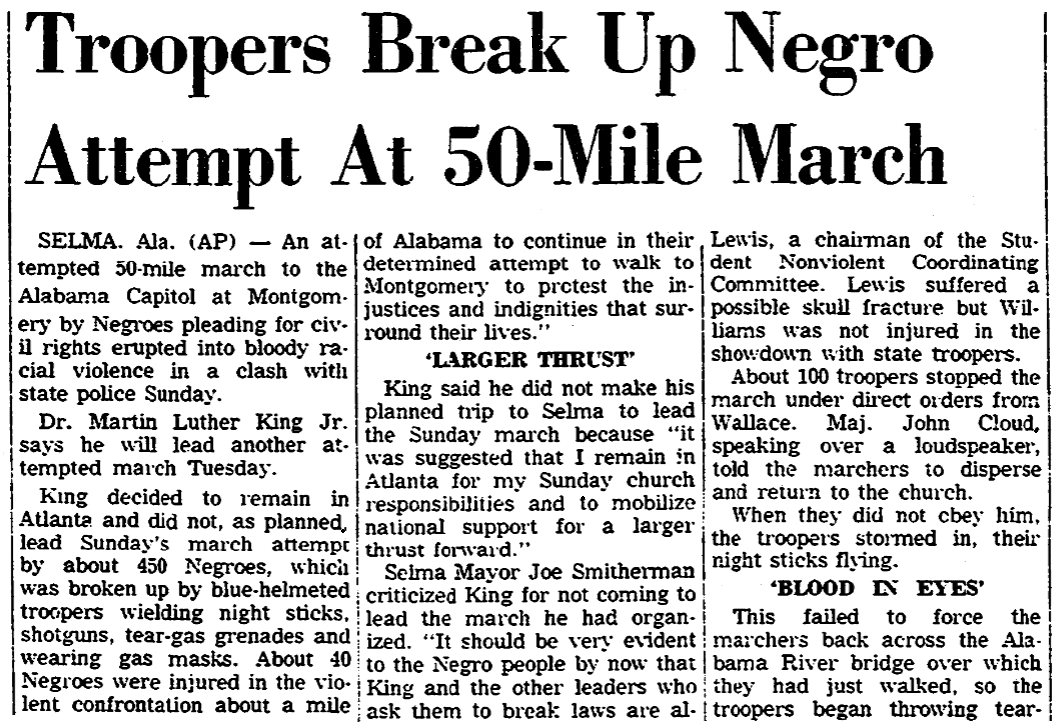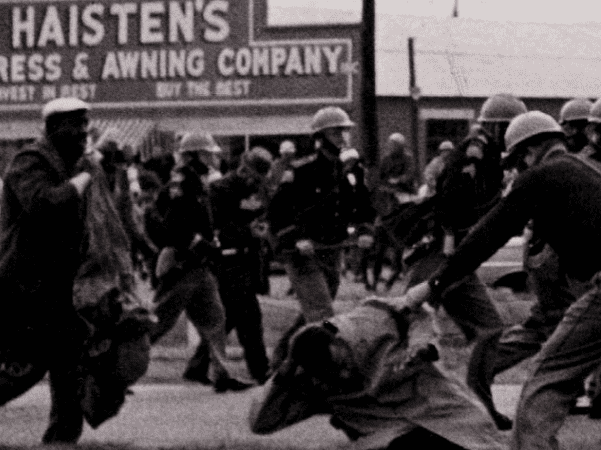Racial hatred was horribly on display in Selma, Alabama, when police attacked a peaceful march of African American demonstrators on 7 March 1965. The violent encounter injured dozens of protesters, 17 seriously enough to require hospitalization, earning the infamous day the nickname “Bloody Sunday.”

The marchers were protesting both the police slaying of civil rights demonstrator Jimmie Lee Jackson on February 18, as well as the hostile conditions in Selma and the surrounding area that intimidated African Americans to prevent them from voting.

Aberdeen Daily News (Aberdeen, South Dakota), 8 March 1965, page 1
Here is a transcription of this article:
Troopers Break Up Negro Attempt at 50-Mile March
SELMA, Ala. (AP) – An attempted 50-mile march to the Alabama Capitol at Montgomery by Negroes pleading for civil rights erupted into bloody racial violence in a clash with state police Sunday.
Dr. Martin Luther King Jr. says he will lead another attempted march Tuesday.
King decided to remain in Atlanta and did not, as planned, lead Sunday’s march attempt by about 450 Negroes, which was broken up by blue-helmeted troopers wielding night sticks, shotguns, tear-gas grenades and wearing gas masks. About 40 Negroes were injured in the violent confrontation about a mile after the march began.
“If it has to be a path of blood, it is going to be established that Negroes have the right to walk on the highways of Alabama,” said the Rev. James Bevel, a lieutenant in King’s Southern Christian Leadership Conference. King was expected in Selma Monday evening.
Road Cluttered
The highway was cluttered with packs, bed rolls and other camping equipment when the melee ended. They had been left behind by Negroes fleeing the tear gas and the club-swinging state troopers.
The troopers later were joined by about 60 members of Sheriff James G. Clark’s Dallas County Posse, some of them on horseback, who prodded and beat the Negroes back to the church from where the march started. The possemen shouted “Get the Niggers off the streets!” as they charged.
The Justice Department announced in Washington that FBI agents in Selma have been ordered to make a complete investigation to determine “whether unnecessary force was used by law officers and others” in halting the march. Atty. Gen. Nicholas Katzenbach said he was in touch with the situation.
Governor Mum
Gov. George Wallace refused to comment.
King said a motion would be filed in federal court at Montgomery Monday seeking an injunction to prevent Wallace and state troopers from halting Tuesday’s march to emphasize the Negroes’ plea for the right to vote in this stronghold of Southern tradition.
Bevel, addressing a mass Negro rally that followed the abortive march, criticized President Johnson for “not fulfilling his promises.”
“Johnson knows that Negroes cannot vote here,” he said.
King, speaking from his home in Atlanta, said: “In the light of Sunday’s tragic event, I have no alternative but to recommend to my close associates and the Negro people of Alabama to continue in their determined attempt to walk to Montgomery to protest the injustices and indignities that surround their lives.”
‘Larger Thrust’
King said he did not make his planned trip to Selma to lead the Sunday march because “it was suggested that I remain in Atlanta for my Sunday church responsibilities and to mobilize national support for a larger thrust forward.”
Selma Mayor Joe Smitherman criticized King for not coming to lead the march he had organized. “It should be very evident to the Negro people by now that King and the other leaders who ask them to break laws are always absent as he was today,” he said.
The march was led by Hosea Williams of the SCLC and John Lewis, a chairman of the Student Nonviolent Coordinating Committee. Lewis suffered a possible skull fracture but Williams was not injured in the showdown with state troopers.
About 100 troopers stopped the march under direct orders from Wallace. Maj. John Cloud, speaking over a loudspeaker, told the marchers to disperse and return to the church.
When they did not obey him, the troopers stormed in, their night sticks flying.
‘Blood in Eyes’
This failed to force the marchers back across the Alabama River bridge over which they had just walked, so the troopers began throwing tear-gas grenades.
“Those troopers came after us with blood in their eyes,” said Williams. “They just couldn’t wait to get us. They really wanted us. I don’t think I’ve ever been so scared.”
Meanwhile, three white men, including a militant segregationist who recently attacked King, were arrested late Sunday on charges of assaulting an FBI agent.
Jimmy George Robinson, 26, a member of the National States Rights party previously convicted of striking King with his fist, also was charged by city police with a separate case of assault and battery against the FBI agent. Another also was accused of taking the agent’s camera.
The agent, Daniel Doyle of Little Rock, said he was attacked and his camera taken while he and other FBI men observed the attempted march. Whether the men knew Doyle was a federal officer or whether they mistook him for a photographer was not established.
The others arrested were identified by special agent Earl Dallness of the Mobile FBI office as Thomas Randall Kendrick, 21, and Noel D. Cooper, also 21.
Crowd Cheers
As the troopers moved in on the marchers the first time, a crowd of several hundred white persons which had gathered about 100 yards away broke into cheers.
The cheering grew louder and the crowd shouted encouragement as the troopers heaved the grenades.
Although the crowd was loud and hostile, it made no attempt to break through heavy police lines to attack the marchers.
As the grenades exploded, the Negroes, who had regrouped after the first charge, knelt by the side of the road to pray. But finally the gas routed them and they began running back across the long bridge that leads into downtown Selma.
Some stumbled over fellow marchers as they ran in panic and state troopers hit them with clubs. The group had marched about a mile from the Browns Chapel A.M.E. Church and they were chased by the posse all the way back to the church.
One downtown street was lined with cars in which Negroes sat watching events.
Beat on Cars
Members of the posse beat on the hoods of the automobiles with their nightsticks and pointed their clubs at the drivers, shouting, “Get the hell out of town! Go on. I mean it! We want all the Niggers off the streets!”
The Negroes all left without protest. Thirty minutes after the marchers’ encounter with the troopers a Negro could not be seen walking the streets.
Note: An online collection of newspapers, such as GenealogyBank’s Historical Newspaper Archives, is not only a great way to learn about the lives of your ancestors – the old newspaper articles also help you understand American history and the times your ancestors lived in, and the news they talked about and read in their local papers – including more recent events.
Related Articles:
